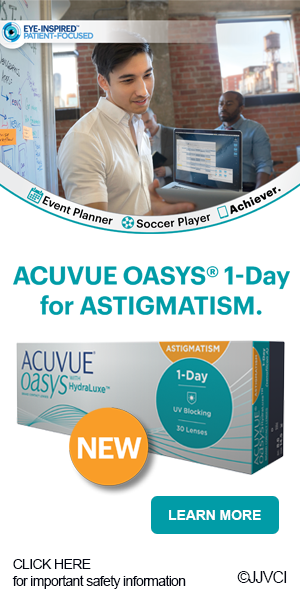Let’s face the facts: people over the age of 45 just don’t wear contact lenses. Guess what? Many practitioners have come to accept this as a reality. And in fact, patients over the age of 45 account for only 30% of all contact lens wearers (Nichols, 2015). Most practitioners don’t want to think about this, and many blame the contact lens industry for not making multifocal lenses that are “worth wearing.”
Reality Check
For years, the contact lens industry has been trying to get patients into multifocal lenses. They have innovated, they have taught us better ways of speaking to our patients, and how have we repaid them? “Well, the lenses still don’t work, and my patients are dropping out. So, I am not going to fit them.” The reality is that your patients are not dropping out because of vision. They are dropping out because of comfort. The top two reasons why people drop out of their lenses are discomfort and dryness (Richdale et al, 2007).
We are certainly not saying that we don’t want better multifocals; we are always looking for innovation. But what we need more than anything is a transformation in our way of managing this comfort issue.
It May Not Be the Lens
It may seem logical to treat contact lens dryness and discomfort by changing the contact lenses and solutions. However, if the lens worked last year but isn’t working now, it is not the lens that has changed. Patients still tell me that they were told by their practitioner that they are no longer able to wear contact lenses and that it is time for them to switch to spectacles.
Successful management of these patients starts with their dryness and discomfort. We have to acknowledge that this is the reason why patients are dropping out of lens wear. Blackie et al (2018) published a paper on the dry eye management of contact lens wearers. After successfully treating their dry eye with a single therapy, the patients were able to wear lenses for four hours longer than before the treatment (Blackie et al, 2018). Neither their lenses nor their solution were changed. We were excited to see that treating the ocular surface could bring about improved comfort for patients who were on the cusp of lens dropout.
By knowing that the ocular surface challenges are the primary reason why people stop wearing contact lenses, practitioners can help solve these problems. We can consider treatments to improve meibomian and lacrimal gland function. We can prescribe procedures and medication. While this may seem intuitive, the reality is that it is not normal in our contact lens world—yet.
The Verdict
In our practices, we have started treating asymptomatic patients if we see that their ocular surface is becoming compromised. Typically, this presents as conjunctival staining or dysfunction of the meibomian glands. No longer are we waiting for patients to become symptomatic. Rather than switching lenses for patients who are noting discomfort, we are prescribing medication, warm compresses, thermal pulsation, and lid scrubs. Then we see them back to ensure that the ocular surface disease aligns with what we want for healthy, long-term contact lens wear.
We believe that 50 is the new 40 for our lens wearers. We are looking for patients in their 40s to wear their lenses successfully and comfortably for another 20 years or longer. CLS
READ more of my article here at Contact Lens Spectrum





